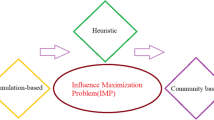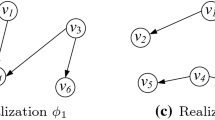Abstract
Influence maximization (IM) aims to find k seed nodes from social network G to maximize the spread of influence under a given diffusion model. However, in real social marketing activities, only some users are connected with marketing initiators. In addition, not all users are willing to be a seed for a specific marketing activity. These factors restrict the range of nodes that can act as seed nodes. Therefore, we first propose the candidate constrained influence maximization (CCIM) problem. Here, only seeds from a predefined set of candidate nodes are selected. Despite the similarity in definition between IM and CCIM, many state-of-the-art algorithms for IM cannot be directly applied to CCIM . We propose a batch processing approach BatchedGreedy for CCIM, which utilizes the efficiency of bit operation in a computer to estimate the spread of influence of nodes in batches. Furthermore, for the traditional influence maximization(IM) problem, we propose the filtering-based BatchedGreedy (FB-BG) algorithm by incorporating node filtering with the BatchedGreedy approach. From experimental statistics, it is shown that FB-BG not only provides better performance than state-of-the-art algorithms in comparable running time, but is also more scalable to larger networks.










Similar content being viewed by others
Notes
A reachable bit set can be implemented by C++ STL or BitSet in Java, and it can also be easily implemented by other computer languages.
References
Kempe D, Kleinberg J, Tardos E (2003) Maximizing the spread of influence through a social network. In: KDD, pp 137–146
Leskovec J, Krause A, Guestrin C, Faloutsos C, Van Briesen J, Glance N (2007) Cost-effective outbreak detection in networks. In: KDD, pp 420–429
Borgs C, Brautbar M, Chayes J, Lucier B (2014) Maximizing social influence in nearly optimal time. In: SODA, pp 946–957
Tang Y, Shi Y, Xiao X (2015) Influence maximization in near-linear time:, A martingale approach. In: SIGMOD, pp 1539–1554
Cheng S, Shen H, Huang J, Zhang G, Cheng X (2013) Staticgreedy: Solving the scalability-accuracy dilemma in influence maximization. In: CIKM, pp 509–518
Goyal A, Lu W, Lakshmanan LV (2011) Celf++: Optimizing the greedy algorithm for influence maximization in social networks. In: WWW, pp 47–48
Cheng S, Shen H, Huang J, Chen W, Cheng X (2014) Imrank: Influence maximization via finding self-consistent ranking. In: SIGIR, pp 475–484
Leskovec J, Krevl A (2014) SNAP Datasets: Stanford large network dataset collection, http://snap.stanford.edu/data
Arora A, Galhotra S, Ranu S (2017) Debunking the myths of influence maximization:, An in-depth benchmarking study. In: SIGMOD, pp 651–666
Feng S, Cong G, Khan A, Li X, Liu Y, Chee YM (2018) Inf2vec: Latent representation model for social influence embedding. In: 2018 IEEE 34th International Conference on Data Engineering (ICDE). IEEE, pp 941–952
Galhotra S, Arora A, Roy S (2016) Holistic influence maximization:, Combining scalability and efficiency with opinion-aware models. In: SIGMOD, pp 743–758
Manchanda S, Mittal A, Dhawan A, Medya S, Ranu S, Singh A (2020) Gcomb: Learning budget-constrained combinatorial algorithms over billion-sized graphs. Adv Neural Info Process Syst, 33:20 000–20 011
Chen H, Qiu W, Ou H, An B, Tambe M (2021) Contingency-aware influence maximization: A reinforcement learning approach. In: Proceedings of the Thirty-Seventh Conference on Uncertainty in Artificial Intelligence, UAI 2021, Virtual Event, 27-30 July 2021, ser. Proceedings of Machine Learning Research, C. P. de Campos, M. H. Maathuis, and E. Quaeghebeur, Eds., vol 161. AUAI Press, pp 1535–1545
Meirom EA, Maron H, Mannor S, Chechik G (2021) Controlling graph dynamics with reinforcement learning and graph neural networks. In: Proceedings of the 38th International Conference on Machine Learning, ICML 2021, 18-24 July 2021, Virtual Event, ser. Proceedings of Machine Learning Research, M. Meila and T. Zhang, Eds., vol 139. PMLR, pp 7565–7577
Caliò A, Tagarelli A (2021) Attribute based diversification of seeds for targeted influence maximization. Inf Sci 546:1273–1305
Zhu J, Ghosh S, Wu W (2019) Group influence maximization problem in social networks. IEEE Trans Comput Soc Syst 6(6):1156–1164
Yin X, Hu X, Chen Y, Yuan X, Li B (2021) Signed-pagerank: An efficient influence maximization framework for signed social networks. IEEE Trans Knowl Data Eng 33(5):2208–2222
Shahrouz S, Salehkaleybar S, Hashemi M (2021) Gim: GPU accelerated ris-based influence maximization algorithm. IEEE Trans Parallel Distributed Syst 32(10):2386–2399
Wu G, Gao X, Yan G, Chen G (2021) Parallel greedy algorithm to multiple influence maximization in social network, ACM Trans. Knowl. Discov. Data, vol 15(3), apr
Karypis G, Kumar V (1998) A fast and high quality multilevel scheme for partitioning irregular graphs. SIAM J Sci Comput 20(1):359–392
Domingos P, Richardson M (2001) Mining the network value of customers. In: KDD, pp 57–66
Min H, Cao J, Yuan T, Liu B (2020) Topic based time-sensitive influence maximization in online social networks. World Wide Web 23(3):1831–1859
Li X, Cheng X, Su S, Sun C (2018) Community-based seeds selection algorithm for location aware influence maximization. Neurocomputing 275:1601–1613
Wang Y, Fan Q, Li Y, Tan K (2017) Real-time influence maximization on dynamic social streams. Proc VLDB Endow 10(7):805–816
Acknowledgements
This work is financially supported by Shenzhen Science and Technology Program under Grant No. JCYJ20210324132406016 and National Natural Science Foundation of China under Grant No.61732022.
Author information
Authors and Affiliations
Corresponding author
Additional information
Publisher’s note
Springer Nature remains neutral with regard to jurisdictional claims in published maps and institutional affiliations.
Rights and permissions
About this article
Cite this article
Han, X., Yao, X. & Huang, H. BatchedGreedy: A batch processing approach for influence maximization with candidate constraint. Appl Intell 53, 6909–6925 (2023). https://doi.org/10.1007/s10489-022-03854-0
Accepted:
Published:
Issue Date:
DOI: https://doi.org/10.1007/s10489-022-03854-0




